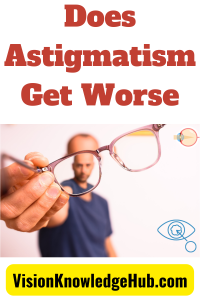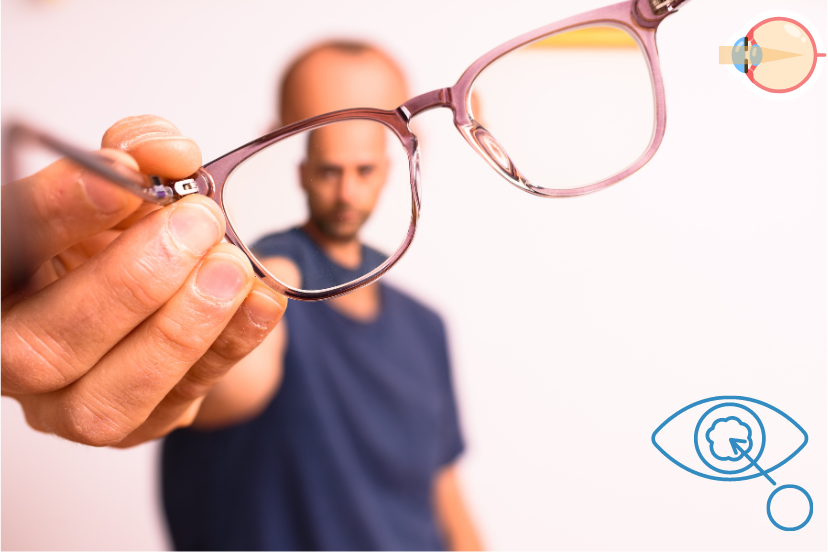Does Astigmatism Get Worse
Astigmatism is a common refractive error that affects the shape of the cornea or lens of the eye, resulting in blurred or distorted vision. If you have been diagnosed with astigmatism, you may wonder if this condition can worsen over time. In this “Does astigmatism get worse” article, we will explore the nature of astigmatism and factors that can influence its progression and discuss ways to manage and treat this visual impairment.
Understanding Astigmatism
Definition Of Astigmatism
This is a refractive error that occurs when the cornea or lens of the eye has an irregular shape. Instead of being round like a basketball, the cornea or lens may be shaped more like a football, causing light to focus unevenly on the retina. This results in blurry or distorted vision at various distances.
Causes of Astigmatism
Both genetic and environmental factors can cause it. It can be present from birth or develop later in life due to factors such as eye injury, eye surgery, or changes in the shape of the cornea or lens.
Types of Astigmatism
There are three main types:
Corneal Astigmatism
This is the most common type, characterized by an irregular shape of the cornea. This irregularity causes light to be focused at multiple points instead of a single point on the retina, leading to blurred or distorted vision. It can be present from birth or can develop due to factors such as corneal injury or conditions that affect the corneal structure. Corrective lenses or refractive surgery can effectively address and improve visual clarity. Regular eye exams are crucial for diagnosing and monitoring to ensure appropriate management.
Lenticular Astigmatism
This is another type that occurs due to irregularities in the shape of the lens in the eye. This can be caused by factors such as lens dislocation, cataracts, or certain eye conditions. It can result in blurred or distorted vision, similar to corneal astigmatism. Corrective measures such as prescription eyeglasses, contact lenses, or refractive surgeries can help address and improve visual acuity. Regular eye examinations are essential for detecting and managing effectively.
Mixed Astigmatism
As the name suggests, mixed astigmatism is a combination of corneal and lenticular astigmatism. This means that both the cornea and lens of the eye have irregularities in their shape, leading to blurred or distorted vision at different distances. Corrective measures for mixed astigmatism may include prescription eyeglasses, contact lenses, or refractive surgeries tailored to address both corneal and lenticular irregularities. Regular eye check-ups are crucial for diagnosing and managing appropriately.
Can Astigmatism Get Worse Over Time?
The Natural Progression Of Astigmatism
It typically stabilizes during adulthood, and the prescription for corrective lenses remains relatively stable. However, in some cases, it can progress over time, leading to changes in vision.
Factors That Can Influence The Worsening Of Astigmatism
Several factors can influence the progression of astigmatism:
- Age: As we age, the lens of the eye becomes less flexible and can develop changes in shape, potentially affecting astigmatism.
- Eye strain: Prolonged periods of near work or extensive use of digital screens can cause eye strain, which may contribute to the progression of astigmatism.
- Eye injury or surgery: Trauma to the eye or certain eye surgeries can alter the shape of the cornea or lens, potentially worsening astigmatism.
- Hormonal changes: Hormonal changes during pregnancy or menopause can sometimes affect the shape of the cornea or lens, leading to changes in vision.
- Eye rubbing: Frequent and vigorous eye rubbing can put pressure on the cornea, potentially affecting its shape and exacerbating astigmatism.
Managing And Treating Your Vision
While astigmatism may worsen in some cases, it is essential to note that proper management and treatment can help minimize its impact on vision. Here are some options:
Regular Eye Exams
Routine eye exams are essential for detecting any changes and ensuring your prescription for corrective lenses remains up to date. Regular visits to an eye care professional can help identify any progression and provide appropriate interventions.
Prescription Eyeglasses And Contact Lenses
Eyeglasses and contact lenses are common methods of correcting astigmatism. A precise prescription can compensate for the irregular shape of the cornea or lens, allowing light to focus properly on the retina. Wearing the prescribed corrective lenses can help reduce the effects and improve vision.
Refractive Surgery Options
For those seeking a more permanent solution, refractive surgery may be an option. Procedures like LASIK or PRK can reshape the cornea, correcting the irregularities that cause astigmatism. It’s important to consult with an eye surgeon to determine if you are a suitable candidate for these surgeries.
Lifestyle Changes To Reduce The Progression
Making specific lifestyle changes can help slow down the progression of astigmatism. These may include:
Taking Breaks From Screens
Frequent breaks from digital screens can reduce eye strain and the potential progression of astigmatism.
Protecting Your Eyes From Injury
Wearing protective eyewear during activities that may pose a risk to the eyes can help prevent eye injuries.
Eating A Healthy Diet
A well-balanced diet rich in antioxidants, vitamins, and minerals can support overall eye health.
Proper Eye Hygiene
Practicing good eye hygiene, such as avoiding rubbing the eyes and keeping contact lenses clean, can help maintain the eyes’ health.
Holistic Approach To Treating Astigmatism
There is no specific holistic treatment that can directly cure astigmatism. Adopting a holistic approach to overall eye health can help manage and prevent the progression of astigmatism.
Here are some holistic practices that may support the well-being of your eyes:
Maintain a healthy diet: Eating a balanced diet rich in vitamins, minerals, and antioxidants can contribute to good eye health. Include foods like leafy greens, fruits, fish, and nuts, which contain nutrients beneficial for the eyes.
Practice eye exercises: Regularly engaging in eye exercises can help improve eye muscle strength and flexibility. These exercises may include focusing on distant objects, blinking frequently, and performing eye rolls or eye massages.
Manage eye strain: Minimize eye strain by taking regular breaks from activities that require intense visual focus, such as working on a computer or reading for long periods. Follow the 20-20-20 rule: every 20 minutes, take a 20-second break and look at something 20 feet away.
Protect your eyes: Wear sunglasses with UV protection to shield your eyes from harmful ultraviolet rays. Additionally, use safety goggles or protective eyewear when engaging in activities that could potentially injure your eyes.
Practice proper eye hygiene: Cleanliness is important for maintaining healthy eyes. Wash your hands before touching your eyes or handling contact lenses. Follow proper contact lens care and hygiene practices to prevent eye infections.
Manage overall health: Certain health conditions, such as diabetes and hypertension, can impact eye health. Managing these conditions effectively through lifestyle modifications and proper medical care can help minimize the risk of complications that may worsen astigmatism.
While these holistic approaches may contribute to overall eye health, consulting with an eye care professional for a comprehensive evaluation and personalized treatment plan is essential.
Conclusion
While astigmatism can sometimes worsen over time, proper management and care can help minimize its impact on your vision. Regular eye exams, prescription eyeglasses or contact lenses, refractive surgeries, and adopting healthy habits can all contribute to maintaining good eye health and managing astigmatism effectively.
Frequently Asked Questions (FAQs)
Can astigmatism go away on its own?
It typically does not go away on its own, but it can be managed effectively with corrective lenses or refractive surgery.
Does wearing glasses worsen astigmatism?
No, wearing the glasses prescribed does not worsen the condition. In fact, it helps correct vision.
Can astigmatism be corrected permanently?
Yes, refractive surgeries like LASIK or PRK can provide permanent correction in many cases. However, eligibility depends on individual factors and should be discussed with an eye care professional.
Is it possible to have astigmatism in only one eye?
Yes, it is possible in one eye while the other eye has normal vision. It is important to address each eye individually.
Can astigmatism cause headaches?
It can cause eyestrain, which may result in headaches. Correcting this with the appropriate lenses or treatment can help alleviate this discomfort.





